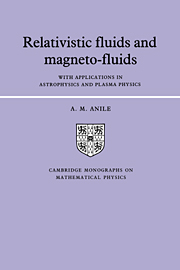Book contents
- Frontmatter
- Contents
- Preface
- 1 Introduction
- 2 Mathematical structure
- 3 Singular hypersurfaces in space-time
- 4 Propagation of weak discontinuities
- 5 Relativistic simple waves
- 6 Relativistic geometrical optics
- 7 Relativistic asymptotic waves
- 8 Relativistic shock waves
- 9 Propagation of relativistic shock waves
- 10 Stability of relativistic shock waves
- References
- Index
9 - Propagation of relativistic shock waves
Published online by Cambridge University Press: 06 January 2010
- Frontmatter
- Contents
- Preface
- 1 Introduction
- 2 Mathematical structure
- 3 Singular hypersurfaces in space-time
- 4 Propagation of weak discontinuities
- 5 Relativistic simple waves
- 6 Relativistic geometrical optics
- 7 Relativistic asymptotic waves
- 8 Relativistic shock waves
- 9 Propagation of relativistic shock waves
- 10 Stability of relativistic shock waves
- References
- Index
Summary
Introduction
The propagation of relativistic shocks is of great relevance to several astrophysical problems. Obviously, it is a central feature of the standard model of supernova explosions (Chevalier, 1981; Shapiro and Teukolsky, 1983). Also, in some models of jet emission in extragalactic radio sources and quasars, relativistic shocks propagate along the jet (Appl and Camezind, 1988, and references therein). In theories of galaxy formation relativistic shocks may occur either as nonlinear developments of adiabatic perturbations (Peebles, 1980) or, being caused by some explosion in the pregalactic material, as seeds for the formation of protogalactic structure (Ikeuchi, Tomisaka, and Ostriker, 1983).
The evolution of relativistic shock waves hitherto has not been studied as extensively as in the nonrelativistic case. Some results have been obtained for the case of self-similar solutions representing blast waves by, among others, Johnson and McKee (1971), Eltgroth (1971, 1972), Blandford and McKee (1976), Deb Ray and Chakraborty (1978), Bogoyavlenski (1978), Moschetti (1987), and Anile, Moschetti, and Bogoyavlenski (1987), and, by using approximate methods, by Ishizuka (1980) and Ishizuka and Sakashita (1980).
For an arbitrary shock wave the problem of its evolution is a fundamental one. The damping of a plane relativistic shock was first investigated by Liang (1977a) and Liang and Baker (1977), who suggested the interesting effect that, at variance with the nonrelativistic case, the damping time would tend to infinity the stronger the shock and this could have important consequences for the nonlinear damping of primeval adiabatic perturbations.
- Type
- Chapter
- Information
- Relativistic Fluids and Magneto-fluidsWith Applications in Astrophysics and Plasma Physics, pp. 276 - 288Publisher: Cambridge University PressPrint publication year: 1990

